Centre Block reno update: project spending to date nears $1-billion
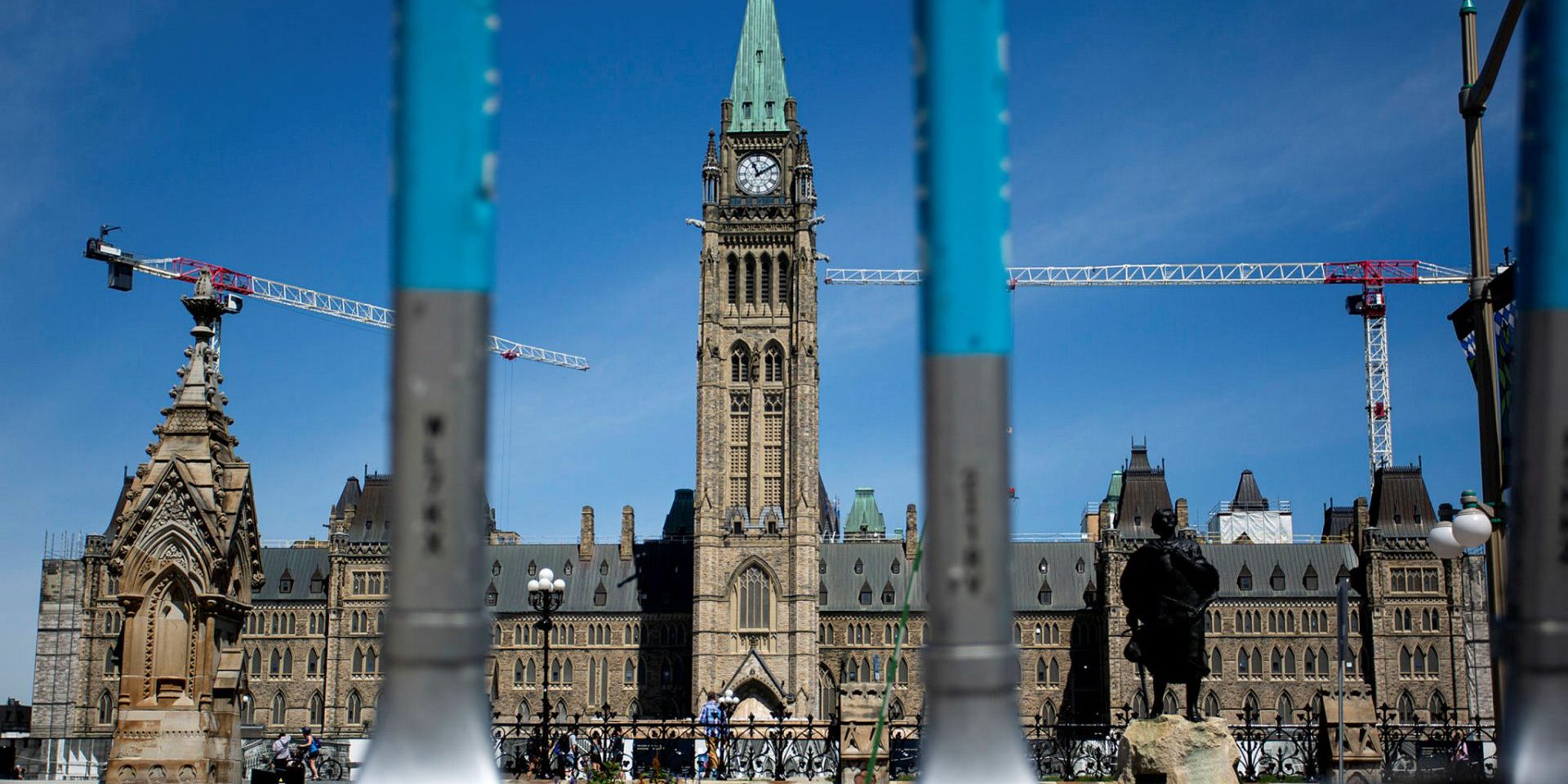
A total of $975-million has now been spent as part of the Centre Block Rehabilitation Project—which includes both the renovation of the 100-year-old building, and construction of a new underground welcome centre complex—out of its estimated $4.5-billion to $5-billion total price tag.
The spending update was included as part of Public Services and Procurement Canada’s (PSPC) most recent quarterly progress report on the project, and represents an increase of $79-million in spending since the last update. The report, which broadly summarizes project progress between July 1 and Sept. 30, was released on Oct. 11.
On the design side, PSPC told The Hill Times by email that spending from the most recent quarter was focused on “advancing designs” for the Parliament Welcome Centre (PWC) and Centre Block, including the “design strategy for high heritage spaces, and key destination spaces” in the welcome centre, like its planned public cafeteria.
“On the construction front, spending within the last quarter is mainly attributed to the Centre Block and includes the purchase and installation of piling and steel bracing to support the transfer of the building load, the construction of concrete shear walls, the purchase of rebar and concrete to continue the level one slab replacement, continuation of the masonry program and installation of scaffolding in the west courtyard,” as well as the drilling of geothermal wells, PSPC explained.
Project health trackers, which had slid closer to the red in the previous quarterly update, remained static, with the project’s schedule still the largest source of concern.
Recent progress highlights include the completion of the installation of 92 geothermal exchange wells along the bottom of the 23-metre-deep pit in front of Centre Block that will house the PWC, which had been 80 per cent complete in the previous update.
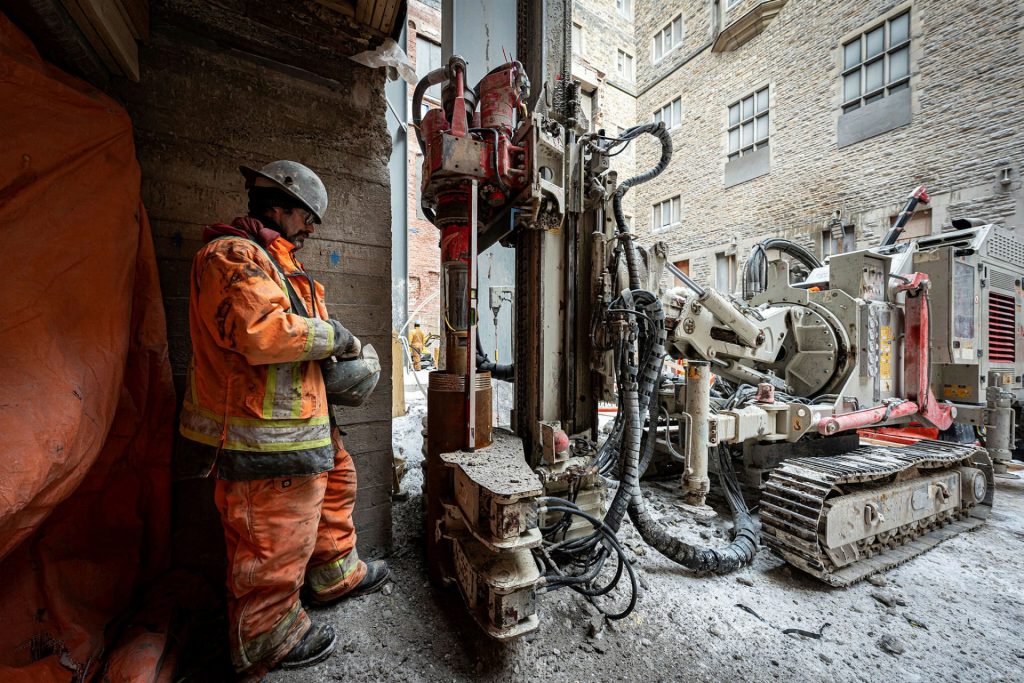
The installation of support posts—or steel piles—that will form part of the network that will hold up Centre Block once required excavations under the historic building begin is now 76 per cent complete, according to PSPC, up from 63 per cent the previous quarter. The department has previously estimated that around 800 steel piles will need to be installed as part of this effort, meaning around 600 are now in place.
Excavation under Centre Block—currently slated to begin in the spring of 2025—is needed to complete base-isolation seismic upgrades, and to connect the main building to the new underground welcome centre.
Also on the to-do list for prepping Centre Block for this work is replacement and reinforcement of the building’s slab. “We continue to make progress in rebuilding the level 1 concrete slab and drilling support posts in the basement,” reads the report.
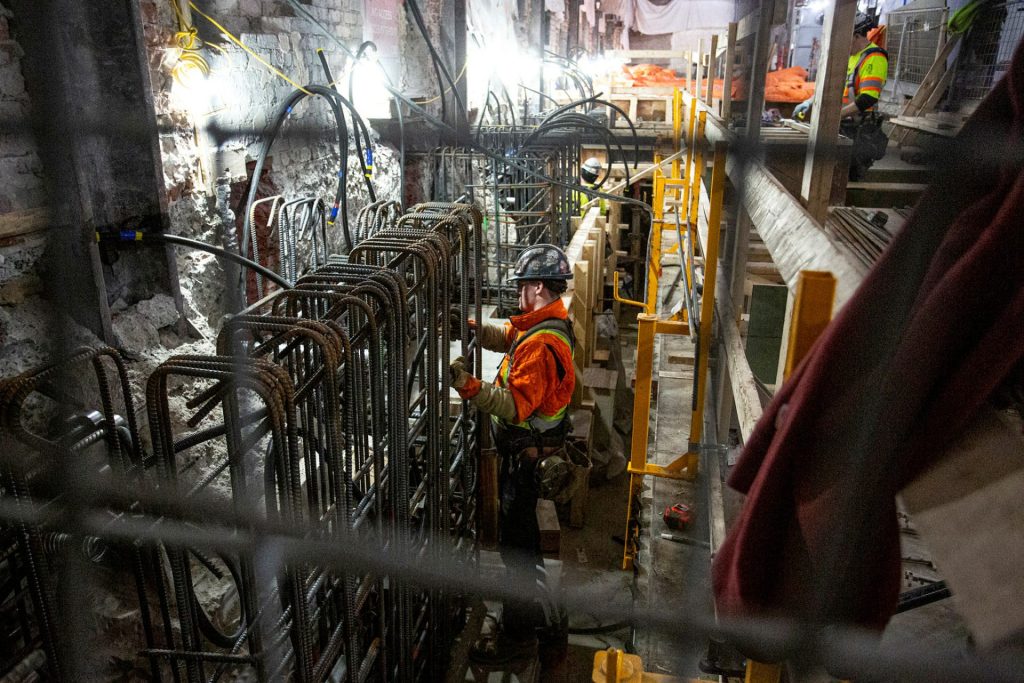
In an email, PSPC specified that, as of September, level 1 concrete slab replacement was roughly 25 per cent complete. Reaching 20 to 25 per cent completion of this work was a “milestone” the department missed last spring, but progress now falls within the 25 to 30 per cent target set for the summer. This fall, PSPC is aiming to have rebuilt 40 per cent of the building’s slab.
All three of the department’s “milestones” for the summer have been checked off, the other two being the start of structural work on the first through sixth floors, and to complete installation of scaffolding along Centre Block’s west façade and its western courtyard that will be needed both for masonry restoration work and installation of a new sloped mansard roof.
“With this scaffold in place, we have started installing a roof enclosure to protect the building during the removal and reconstruction of the roof,” replacement of which is set to begin this winter, said PSPC by email.
Structural work to date has focused on Centre Block’s uppermost fifth and sixth floors, and has involved “installing bracing to support the building as we remove outdated elements to facilitate the upcoming upgrades”—a list that includes new elevator shafts, stairwells, wall construction, and incorporation of new mechanical, electrical, and plumbing systems.
Masonry restoration is now overall roughly 18.5 per cent complete, up from 17.5 per cent in the previous quarter. The north façade was already 100 per cent finished, and progress on the east façade has jumped from 36.5 per cent to 39.5 per cent complete, while the west façade has gone from 21 per cent complete to 26.5 per cent.
CIBA says ‘no’ to swing space proposal
Senators have thrown a wrench into PSPC’s attempt to take a one-phase approach to the future renovation of the Confederation Building, which is home to MP offices.
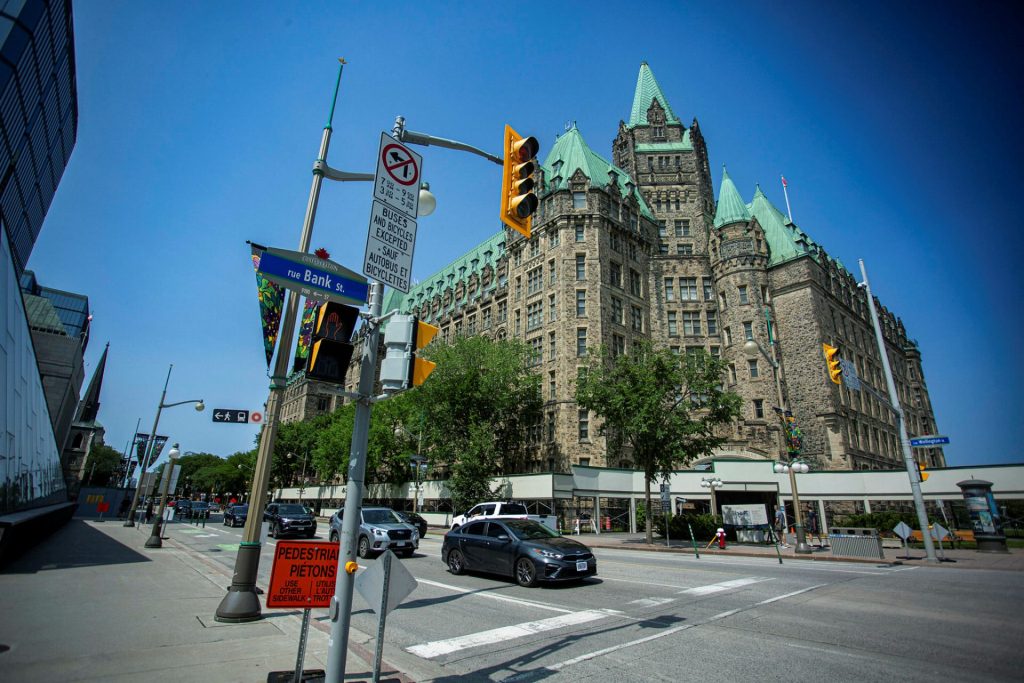
On Oct. 10, members of the Senate Internal Economy, Budgets, and Administration Committee (CIBA) adopted a subcommittee report recommending against giving an OK—at least for now—to the department’s pitch to use part of the Senate’s share of Block 2 offices as interim space for MPs in order to clear out the Confederation Building and renovate it in one go, rather than tackling its renovation in phases.
Construction of the new office complex to be built in Block 2—bounded by Metcalfe and O’Connor, and Sparks and Wellington streets—is only just getting going, and is roughly estimated to be finished by the early 2030s. It will include more than 150 parliamentarian offices, with 94 designated for MPs and 54 for Senators, in addition to other meeting spaces, multi-purpose rooms, a cafeteria, administration offices, and more.
After Block 2, the Confederation Building and the East Block are next in line for renovation as part of PSPC’s multi-year, multibillion-dollar project to revamp Parliament Hill, known as the Long-term Vision and Plan (LTVP).
In May, the House Board of Internal Economy, Budgets, and Administration’s (BOIE) LTVP working group gave PSPC the green light to explore a potential one-phase approach to renovating the Confederation Building, which current approved plans would see renovated in multiple phases while still partly occupied.
At a May 2 meeting, Deputy Speaker Chris D’Entremont (West Nova, N.S.), chair of the working group, explained that PSPC had “identified an opportunity” to tackle the Confederation Building in one phase, which would shave an estimated four years off the project’s schedule, offer cost savings—including by “avoiding sunk costs and off-hour premiums”—and would mean less disruption for MPs, in part by avoiding the need for multiple moves.
Speaking to the BOIE, PSPC acting assistant deputy minister Jennifer Garrett highlighted that finding “appropriate swing space” is key to enabling such an approach, but while the department is “leaving no stone unturned,” options within the “tight geographical boundaries” that make up the Parliamentary Precinct are slim.
The House’s share of new Block 2 office space has already been dedicated as swing space for MPs who will be displaced from the Confederation Building, but with 162 office units needing to be relocated overall, more space is required.
At the May meeting, BOIE members discussed the possibility of leveraging the Senate’s share of Block 2 offices, as well.
The idea hasn’t been embraced by Senators.
On Oct. 10, Conservative Senate Leader Don Plett (Landmark, Man.), a member of the Senate’s LTVP subcommittee, told CIBA the group believes “the House will need something in the neighbourhood of 34 temporary office spaces to cover the shortfall of office space if MPs need to move out of the Confederation Building sooner than they originally planned.” However, PSPC has been “unable” to provide “precise timelines” for when those move-outs will need to begin, or a timeline by which the building will be renovated and ready for re-occupancy, he said.
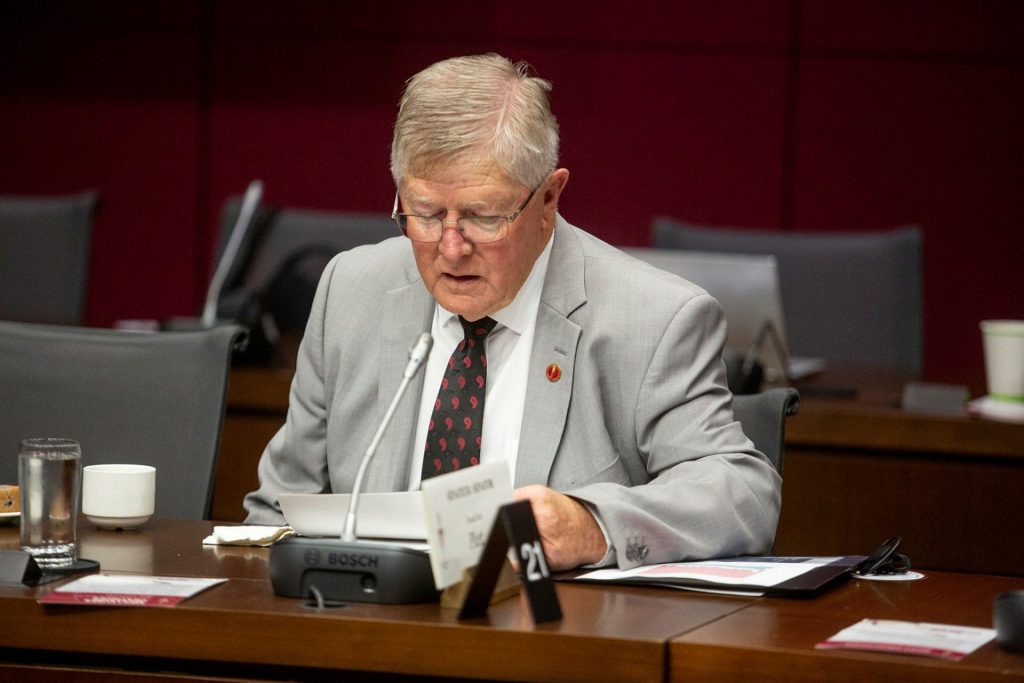
The Senate’s share of Block 2 offices are currently set to be used to relocate remaining East Block residents—46 offices—once renovation of that building begins. In 2022, the Senate reworked its plans to bump up renovation of the Victoria Building—which also houses offices and sits within Block 2—to be done as part of that block’s overhaul. Previously, the East Block had been set to be tackled first, followed by the Victoria Building, but its full renovation is now set to follow completion of both the Block 2 and Centre Block projects.
Plett noted that if the recent pitch is accepted, it would further delay Senators’ move out of East Block “by at least seven years.”
“Based upon the number of variables that are unknown at this time, the subcommittee believes it is far too early to begin discussing a major change to the Senate’s long-term accommodation plans, which have been in place for a few years already,” said Plett. “We also believe that our permanent end-state building should not be used as temporary space for MP offices,” but are “willing to work with” the House and PSPC to “find alternatives from the Senate’s inventory of office spaces as they become available.” This includes the Senate of Canada Building, and the Chambers Building at 40 Elgin St., which is already home to Senators displaced by Centre Block’s renovation.
Centre Block contract updates
A few contracts awarded in connection with the Centre Block project have been amended in recent months.
On July 17, the contract for architectural and engineering services—first awarded to Centrus, a joint venture being led by WSP Canada, in 2017 when it was valued at $127.4-million—was once again amended to increase the total estimated contract by almost $54-million, bringing its total value to $597.4-million. The contract, which was originally slated to expire in April 2021, now runs through to the end of 2033.
On Oct. 9, an amendment valued at almost $646-million was posted in connection to the construction management services contract for the Centre Block project held by a joint venture of PCL Constructors and EllisDon. First awarded in 2017—when it was valued at roughly $598.1-million—the contract’s current total value is $3.5-billion.
A week later, the contract for project management support services, which was first awarded to a joint venture of Colliers Project Leaders and Tiree Facility Solutions in January 2017, was amended to both increase the total expenditure limit by $6.8-million, and extend its duration to the end of 2029. Originally valued at almost $15-million through to the end of 2021, the latest update brings the contract’s total value to roughly $39.3-million.
Plus, one new contract was awarded this month for electrical upgrades tied to Centre Block Underground Services, the moniker given to the building’s existing basement level that houses its electrical guts. Posted on Oct. 8, the current 12-month contract awarded to Arc & Spark Electric—referred to as 1663587 Ontario Inc., in the online notice—is valued at $337,870.
Editor’s Note: This story was updated on Oct. 30 at 4:43 p.m. to correct that excavation under Centre Block is currently slated to begin in the spring of 2025, not September 2025 as previously stated.
The Hill Times






 LICENSING
LICENSING PODCAST
PODCAST ALERTS
ALERTS













